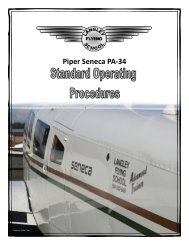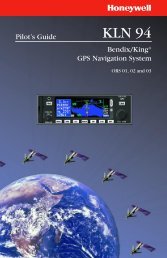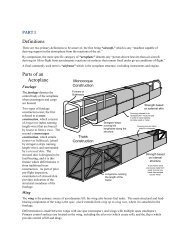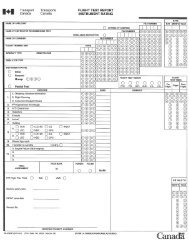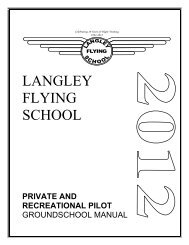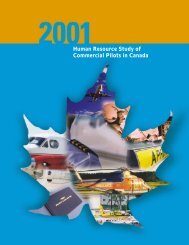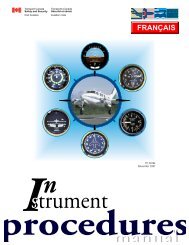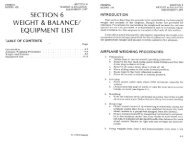LANGLEY FLYING SCHOOL Flight Training Handbook
LANGLEY FLYING SCHOOL Flight Training Handbook
LANGLEY FLYING SCHOOL Flight Training Handbook
Create successful ePaper yourself
Turn your PDF publications into a flip-book with our unique Google optimized e-Paper software.
<strong>Flight</strong> <strong>Training</strong> <strong>Handbook</strong> Page 24<br />
Langley Flying School, Inc.<br />
While SOPs familiarity is an integral part of professional flying, your first flying job in an advanced aircraft will<br />
likely be a right-seat job as Second-in-command. Our commercial students begin immediately learning to fly from<br />
the right seat and your Instructor will regularly assign seat changes during the course of training.<br />
In an effort to broaden the experience of our students, the Commercial Pilot Program includes optional advanced<br />
aircraft exercises. The first, entitled Advance Aircraft Operations—Introduction to Complex Aircraft, introduces<br />
students to constant-speed propeller, retractable gear, and cowl flap systems, while the second, entitled Advance<br />
Aircraft Operations—Low-level Commercial <strong>Flight</strong> Operations, simulates a VFR commercial cross-country flight<br />
utilizing airway navigation, ATC radar services, and GPS operations. A third optional course, entitled Advance<br />
Aircraft Operations: High-level Commercial <strong>Flight</strong> Operations, simulates an IFR commercial flight in Class A<br />
airspace. Students are trained on the use of supplemental oxygen and engine turbochargers. These optional<br />
exercises are described in the Commercial Pilot Program Course Outline.<br />
Paperwork<br />
With every flight there is paperwork. Your Instructor documents each training flight in your Pilot <strong>Training</strong> Record<br />
(PTR), describing the training that occurred, including specific areas of focus or improvement for subsequent flights.<br />
When you have completed your training, your PRT will be submitted to Transport Canada as documented proof of<br />
meeting ground and air training requirements. You are encouraged to examine your PTR regularly and in this<br />
regard the PTR becomes a learning tool. You are also encouraged to make comments in the PTR, and this is of<br />
particular value to us in reference to solo training flights.<br />
In addition to the PTR, each training flight is documented in student’s Pilot Log Book. The Pilot Log Book is<br />
essentially your record and proof of training. Transport Canada has the right to audit any Pilot Log Book associated<br />
with the application for a pilot licence and rating, and it is important, especially if you are considering a career in<br />
professional flying, that the Pilot Log Book is maintained accurately. For initial pilot training, the Pilot Log Book<br />
must essentially be a duplicate of the PTR; for students pursuing a Commercial Pilot Licence, an audit of the Pilot<br />
Log Book by Transport Canada in support of the application is assured.<br />
At Langley Flying School, students are responsible (subject to Instructor supervision) to ensure the <strong>Flight</strong> <strong>Training</strong><br />
Log is properly completed for each flight. <strong>Flight</strong> <strong>Training</strong> Log entries that are required before flight includes<br />
aircraft weight and balance, aircraft fuel, and the scheduled training exercises; while entries required after the flight,<br />
include takeoff and landing time, flight time (based on the Hobbs Meter) and air time (based on time in the air). It is<br />
the clear responsibility of students to make sure that all of this information is properly recorded; it is the<br />
responsibility of the Instructor to ensure this is done.<br />
The Aircraft Journey Log is a legally defined document that records the usage of the aircraft. Since the Aircraft<br />
Journey Log record of aircraft usage determines when an aircraft receives scheduled maintenance, and since the<br />
Aircraft Journey Log is the central record of all aircraft defects and unserviceabilities, the accuracy of entries made<br />
in this book is critical for flight safety. Also, be aware that the training flight scheduled after yours cannot be<br />
released until the Aircraft Journey Log is completed. Special care must be made in making accurate and correct<br />
entries in Aircraft Journey Logs—if you are unsure of something, ask.<br />
Borrowing Books<br />
Langley Flying School maintains a small but useful library of books and videos, and students are encouraged to use<br />
this material. Importantly, however, material must be signed out on a sheet that is posted in the front office.<br />
The Intel File<br />
One of the most important books available is Langley Flying School’s Intel File. The Intel File contains a record of<br />
notes made by students who have written Transport Canada written examinations. The records are informal, but this<br />
book will provide extensive insight into the questions that appear on these examinations. It is fundamental to<br />
student success that you ensure you examine Intel File before you write your Transport Canada examination, but it<br />
is equally important that you make a contribution to the Intel File when you have completed your examinations—<br />
resume and will draw attention from a prospective employer. As you will quickly discover when you compose your first commercial pilot<br />
resume, it is often a challenge to fill the space with meaningful aviation-related information. Our goal has been to put together solid training<br />
behind the certification process, which of course reflects on our reputation as a training institution.<br />
2012 David L. Parry



